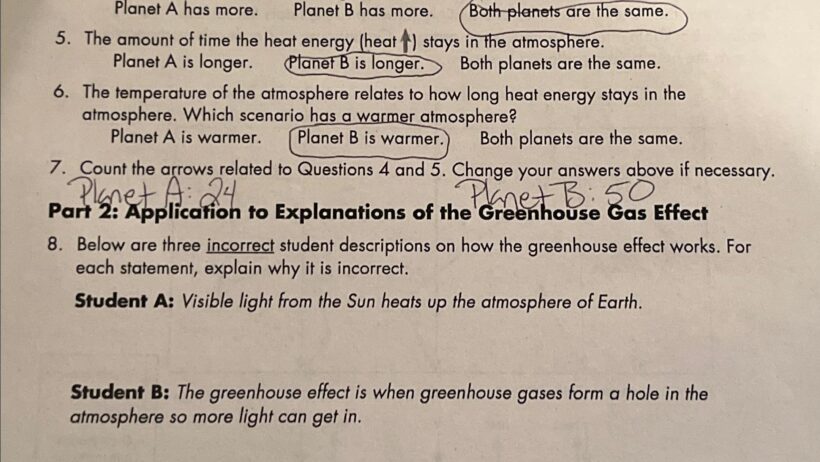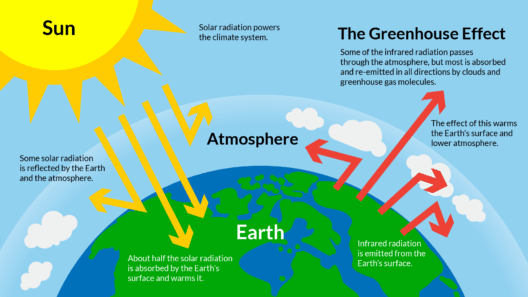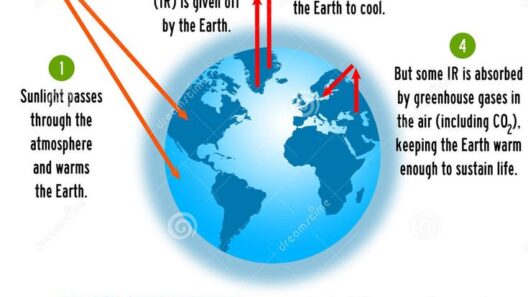Exploring the intricacies of planetary atmospheres quickly unveils a captivating phenomenon known as the greenhouse effect. But which planets actually experience this climatic phenomenon? Can we glean clues about our own planet’s future by investigating others in our solar system? Let’s embark on an enlightening journey through space to uncover the planets that experience greenhouse gas effects, the underlying mechanisms involved, and the implications for both our world and the cosmos.
Understanding Greenhouse Gases: The Essentials
Before we delve deeper into the realities of other planets, it’s pertinent to understand how greenhouse gases function in an atmosphere. The greenhouse effect is a natural process where certain gases trap heat from the sun, preventing it from escaping back into space. The most prevalent greenhouse gases include carbon dioxide (CO2), methane (CH4), and water vapor (H2O).
The sun’s energy reaches a planet’s surface, warming it. Subsequently, the surface radiates this energy as infrared radiation. Greenhouse gases absorb and re-emit this infrared energy, creating a warming effect similar to that of a greenhouse. This process is vital for maintaining temperature and climate, rendering planets hospitable. However, excess greenhouse gases can exacerbate warming, leading to severe climate imbalances.
A Closer Look at Venus: The Greenhouse Champion
Unquestionably, Venus reigns supreme in the realm of greenhouse effects within our solar system. Often dubbed Earth’s “sister planet” due to its similar size and proximity, Venus is shrouded in thick clouds primarily composed of carbon dioxide along with traces of sulfuric acid.
Venus’s surface temperature averages a blistering 467 degrees Celsius (872 degrees Fahrenheit), far hotter than Mercury, despite being nearly twice as distant from the sun. The immense pressure—over 90 times that of Earth—coupled with a predominance of greenhouse gases creates a runaway effect, rendering it a prime example of how unchecked greenhouse gas concentrations can propel temperatures to extremes.
Additionally, the atmosphere of Venus fails to cycle these gases out effectively, locking in the heat. As we assess climate change on Earth, the cautionary tale of Venus serves as a stark reminder of the possible ramifications of uncontrolled greenhouse emissions.
Mars: A Past with Hope and a Dismal Present
In stark contrast, Mars presents a relatively diminished greenhouse effect today, primarily due to its thin atmosphere, which is 95% carbon dioxide. However, this atmosphere is a mere 0.6% the pressure of Earth’s, rendering it unable to sustain substantial greenhouse heating. As a result, the average surface temperature on Mars hovers around a frigid minus 63 degrees Celsius (minus 81 degrees Fahrenheit).
Planetary scientists theorize that Mars once had a thicker atmosphere that may have supported liquid water and a climate conducive to life. Fossilized evidence of ancient riverbeds and lake beds point to a different era—one where greenhouse gases could have played a role in retaining warmth. Yet, over millions of years, the loss of magnetosphere and subsequent atmospheric erosion led to the current inhospitable conditions.
What might Mars tell us about the long-term sustainability of Earth? If greenhouse gas concentrations were once sufficient to create a warmer environment, what triggered the atmospheric escape?
Earth: A Personal Guardian of Greenhouse Gases
Among the planets we inhabit, Earth represents a delicate balance in the greenhouse effect. While naturally occurring greenhouse gases sustain temperatures that enable life, human activity has significantly disrupted this balance. Industrialization, deforestation, and fossil fuel combustion have led to an alarming increase in CO2 levels, magnifying the natural greenhouse effect and heralding climate change challenges.
An unusual conundrum arises: Our well-intentioned efforts to harness technologies that propel modern civilization inadvertently amplify the very challenges we seek to mitigate. Earth’s current greenhouse gas concentrations have reached levels unseen in thousands of years, raising serious concerns about our ability to regulate warming and its associated impacts—ranging from extreme weather, rising sea levels, to disruptions in ecosystems.
Understanding the trajectories of greenhouse emissions requires an examination of Earth’s capacity for self-regulation. While certain systems are in place to stabilize our climate, the question remains—will we act in tandem with Nature, or do we risk a future echoed in the histories of Mercury, Venus, and Mars?
The Outliers: Gas Giants and Icy Realms
Interestingly, not all planets contend with the same atmospheric phenomena. The gas giants—Jupiter, Saturn, Uranus, and Neptune—exhibit unique atmospheric dynamics that render them largely immune to the conventional greenhouse effect as seen on terrestrial planets. Their thick atmospheres, composed primarily of hydrogen and helium, may contain trace amounts of propane, ethane, and ammonia, which can contribute to localized warming.
In contrast, icy moons and dwarf planets like Pluto signify a different type of challenge. While these celestial bodies lack substantial atmospheres, the question of cryovolcanism and the potential for subsurface oceans presents an intriguing scenario where greenhouse-like effects may be worthy of exploration. They remind us that even in the cold darkness of space, pockets of unusual warmth may exist.
Final Thoughts: The Future of Our Planet in Cosmic Light
As we examine the complexities of greenhouse effects across various planets, the warnings echo loudly. The lessons gleaned from Venus’s oppressive climate, Mars’s ghostly remnants, and Earth’s precarious balance all converge into a broader conversation about sustainability. One must ponder: how resilient is the Earth, and how long can we sustain a livable environment in the face of rapid atmospheric changes?
By exploring the greenhouse effects on other planets, we can glean insights that illuminate our path forward. The ongoing challenges of climate change are not confined to Earth but are woven into the cosmic fabric of our solar system. Our ability to understand and combat these trends may hold the key to ensuring our planet’s future—a future where life thrives amid the mysteries of the cosmos.








